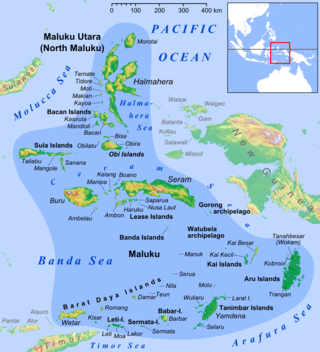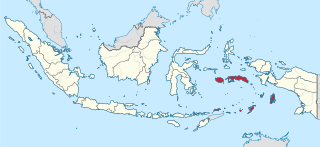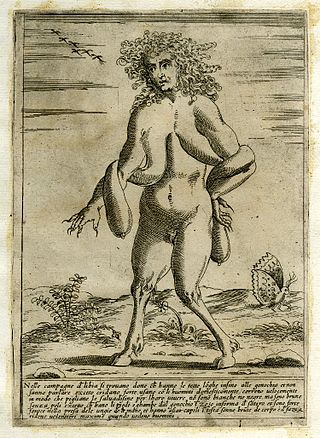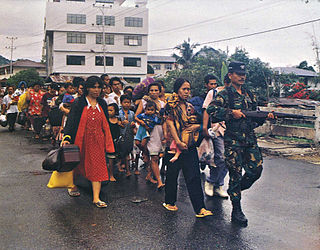Suanggi or Suangi [1] is a malevolent spirit in the folklore of many regions in Eastern Indonesia.
Contents
![Suanggi dance [id] used to exorcise the evil spirits, from Waropen, Papua Tari Soanggi.jpg](http://upload.wikimedia.org/wikipedia/commons/thumb/4/4d/Tari_Soanggi.jpg/280px-Tari_Soanggi.jpg)
Suanggi or Suangi [1] is a malevolent spirit in the folklore of many regions in Eastern Indonesia.
![Suanggi dance [id] used to exorcise the evil spirits, from Waropen, Papua Tari Soanggi.jpg](http://upload.wikimedia.org/wikipedia/commons/thumb/4/4d/Tari_Soanggi.jpg/280px-Tari_Soanggi.jpg)
According to W. R. van Hoëvell, Suanggi is an evil spirit in the shape a person having magical power to cause disease and illness. [2] Suanggi is also a Moluccan Malay term for villagers suspected of being cannibal witches. [3] The accusation of being a Suanggi would be fatal, for those who were allegedly proven to be a Suanggi would be killed and their corpses would be thrown into the sea. [4]
Following the 1999–2000 sectarian conflict that took place in Tobelo, a town and a district in the island of Halmahera, a malevolent female spirit that appeared later in that area was named Suanggi. The spirit manifested itself in February 2004 in the form of a young woman, haunting the Tobelo area for about two months. It was an allegedly unconventional form of Suanggi that was identified with O Tokata , a local malevolent spirit. [5] Suanggi appeared as a beautiful woman that enticed young men, particularly teachers. When the man agreed to have sex with her she would attack him and devour his genitals. The presence of the spirit created an atmosphere of fear not only in Tobelo but in other places of North Maluku as well. Villagers, particularly the children, were forbidden to go outside their homes in the night.
It was claimed that this Suanggi was the vengeful ghost of a Muslim girl seeking retribution against her attackers. The young woman had been the daughter of a Tobelo village leader and she had been raped and brutally murdered by a group of young men during the 1999–2000 riots in the town. After her death her whereabouts were unknown, but six months later the location of her body lying in a ravine was revealed to a diviner in a dream. When her mortal remains were found in that location, a formal burial ceremony was performed. It was believed that the spirit of this girl had assumed a revengeful form motivated by trauma. [5]
Later in 2004, during the first national election in Eastern Indonesia, a local Christian farmer heard the loud wailing cries of a woman near his plantation. He claimed that they came from the bloodthirsty spirit Suanggi "as if she was crying into a megaphone", similar to the loud speakers widely used in Tobelo during the election campaign. The place where the cries were heard was the precise location where large massacres had taken place during the 1999–2000 riots between the Christians and the Muslims in which more than 800 people were killed. [6]
Suanggi beliefs exist in Maluku's neighboring province of East Nusa Tenggara. In 2010-2011, two houses were destroyed by mobs in Adonara, East Flores Regency, due to the occupants being believed to be suanggi. [7] The East Nusa Tenggara Tourism Office plans to coordinate a race for suanggi to fly as one of the events related to Expo Alor 2019. [8]

The Maluku Islands or the Moluccas are an archipelago in the eastern part of Indonesia. Tectonically they are located on the Halmahera Plate within the Molucca Sea Collision Zone. Geographically they are located east of Sulawesi, west of New Guinea, and north and east of Timor. Lying within Wallacea, the Moluccas have been considered a geographical and cultural intersection of Asia and Oceania.

The Kuntilanak, also called Pontianak, or Yakshi is a mythological creature in Indonesia, Malaysia and Singapore. It is similar to Langsuir in other Southeast Asia regions. The Kuntilanak usually takes the form of a pregnant woman who died during childbirth. Alternatively, it is often described as a vengeful female spirit. Another form of the Kuntilanak refers to the ghost or white lady of Southeast Asian folklore.

West Nusa Tenggara is a province of Indonesia. It comprises the western portion of the Lesser Sunda Islands, with the exception of Bali which is its own province. The area of this province is 19,675.89 km2 (7,596.90 sq mi) which consists of two main islands, namely Lombok Island and Sumbawa Island as well as several other small islands. The two largest islands in this province are the smaller but much more populated Lombok in the west and the much larger in area but much less densely populated Sumbawa island in the east. Mataram, on Lombok, is the capital and largest city of the province. It shares maritime borders with Bali to the west and East Nusa Tenggara to the east.

Maluku is a province of Indonesia. It comprises the central and southern regions of the Maluku Islands. The largest city and capital of Maluku province is Ambon on the small Ambon Island. It is directly adjacent to North Maluku, Southwest Papua, and West Papua in the north, Central Sulawesi, and Southeast Sulawesi in the west, Banda Sea, Australia, East Timor and East Nusa Tenggara in the south and Arafura Sea, Central Papua and South Papua in the east. The land area is 57803.81 km2, and the total population of this province at the 2010 census was 1,533,506 people, rising to 1,848,923 at the 2020 census, the official estimate as at mid 2023 was 1,908,753. Maluku is located in Eastern Indonesia.

Kupang, formerly known as Koepang or Coupang, is the capital of the Indonesian province of East Nusa Tenggara. At the 2020 Census, it had a population of 442,758; the official estimate as of mid-2023 was 466,632. It is the largest city and port on the island of Timor, and is a part of the Timor Leste–Indonesia–Australia Growth Triangle free trade zone. Geographically, Kupang is the southernmost city in Indonesia.

The Krasue is a nocturnal female spirit of Southeast Asian folklore. It manifests as the floating, disembodied head of a woman, usually young and beautiful, with her internal organs still attached and trailing down from the neck.

Tobelo is a town and a district on the eastern Indonesian island of Halmahera. It is the capital of the regency (kabupaten) of North Halmahera, part of the province of North Maluku. The town was formalised as the capital of North Halmahera in the district elections held in 2004. It had a population of 34,150 at the 2020 Census. A palm tree lined coastal road connects Tobelo to Galela. The town is predominantly Muslim with a large Christian minority and a Protestant Church has existed in Tobelo since at least 1924.

Pocong is a ghost that looks like a person wrapped in a funeral cloth. In Islamic funeral, a shroud called a "kain kafan" is used to wrap the body of the dead person. The dead body is covered in white fabric tied over the head, under the feet, and on the neck, and the shroud is firmly tied at multiple junctures to maintain its position during the journey to the grave site. Upon placement into the grave, it is believed that the knots must be undone or the corpse will animate and be known as a Pocong. Pocong is also known in Malaysia as Hantu Bungkus.

Moyo is an island off the north coast of Sumbawa Island, in Sumbawa Regency, West Nusa Tenggara province, Indonesia.

The following outline is provided as an overview of and topical guide to Indonesia:

Bloody Mary is a legend of a ghost, phantom, witch, or spirit conjured to reveal the future. She is said to appear in a mirror when her name is chanted repeatedly. The Bloody Mary apparition may be benevolent or malevolent, depending on historic variations of the legend. Bloody Mary appearances are mostly witnessed in group participation play.

North Halmahera Regency is a regency of North Maluku Province, Indonesia. It was declared a separate Regency on 25 February 2003, formed from part of the former North Maluku Regency. The capital town of the regency lies at the port of Tobelo. The Regency, which was considerably reduced by the separation of Morotai Island to form a separate regency on 26 November 2008, now covers an area of 3,404.27 square kilometres (1,314.40 sq mi) and had a population of 161,847 people at the 2010 Census, 179,783 at the 2015 Intermediate Census. and 197,640 at the 2020 Census. The official estimate as at mid 2023 was 203,213. The principal settlements are Tobelo, Kao and Galela. The area is noted for its white beaches and coral reefs.

Wewe Gombel is a female supernatural being or vengeful ghost in Javanese mythology. It is said that she kidnaps children.

The Maluku sectarian conflict was a period of ethno-political conflict along religious lines that occurred in the Maluku Islands in Indonesia, with particularly serious disturbances on the islands of Ambon and Halmahera. The duration of the conflict is generally dated from the start of the Reformasi era in early 1999 to the signing of the Malino II Accord on 13 February 2002.
Daayan, Ḍāin or Ḍāini is often mistakenly regarded as a rendering for a witch in Indian folklore, the term has been derived from the Sanskrit word dakini, which refers to a female paranormal entity from patala. Dakinis have been described in medieval Hindu texts such as the Bhagavata Purana, Brahma Purana, Markandeya Purana and Kathasaritsagara as female fiendish spirits in the train of Kali who feed on human flesh.

In mythology and folklore, a vengeful ghost or vengeful spirit is said to be the spirit of a dead person who returns from the afterlife to seek revenge for a cruel, unnatural or unjust death. In certain cultures where funeral and burial or cremation ceremonies are important, such vengeful spirits may also be considered as unhappy ghosts of individuals who have not been given a proper funeral.
O Tokata is a spirit of the dead in the mythology of Tobelo, Halmahera Island, North Maluku province, Indonesia.

Ghostlore is an intricate web of traditional beliefs and folklore surrounding ghosts and hauntings. Ghostlore has ingrained itself in the cultural fabric of societies worldwide. Defined by narratives often featuring apparitions of the deceased, ghostlore stands as a universal phenomenon, with roots extending deeply into human history.